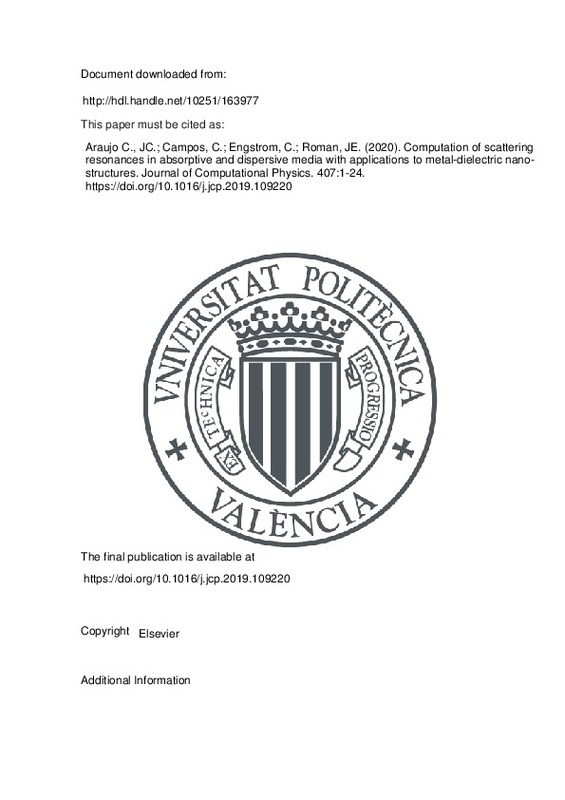Schuller, J. A., Barnard, E. S., Cai, W., Jun, Y. C., White, J. S., & Brongersma, M. L. (2010). Plasmonics for extreme light concentration and manipulation. Nature Materials, 9(3), 193-204. doi:10.1038/nmat2630
Jørgensen, J. T., Norregaard, K., Tian, P., Bendix, P. M., Kjaer, A., & Oddershede, L. B. (2016). Single Particle and PET-based Platform for Identifying Optimal Plasmonic Nano-Heaters for Photothermal Cancer Therapy. Scientific Reports, 6(1). doi:10.1038/srep30076
Engström, C., & Torshage, A. (2018). Accumulation of complex eigenvalues of a class of analytic operator functions. Journal of Functional Analysis, 275(2), 442-477. doi:10.1016/j.jfa.2018.03.019
[+]
Schuller, J. A., Barnard, E. S., Cai, W., Jun, Y. C., White, J. S., & Brongersma, M. L. (2010). Plasmonics for extreme light concentration and manipulation. Nature Materials, 9(3), 193-204. doi:10.1038/nmat2630
Jørgensen, J. T., Norregaard, K., Tian, P., Bendix, P. M., Kjaer, A., & Oddershede, L. B. (2016). Single Particle and PET-based Platform for Identifying Optimal Plasmonic Nano-Heaters for Photothermal Cancer Therapy. Scientific Reports, 6(1). doi:10.1038/srep30076
Engström, C., & Torshage, A. (2018). Accumulation of complex eigenvalues of a class of analytic operator functions. Journal of Functional Analysis, 275(2), 442-477. doi:10.1016/j.jfa.2018.03.019
Lesina, A. C., Vaccari, A., Berini, P., & Ramunno, L. (2015). On the convergence and accuracy of the FDTD method for nanoplasmonics. Optics Express, 23(8), 10481. doi:10.1364/oe.23.010481
Lenoir, M., Vullierme-Ledard, M., & Hazard, C. (1992). Variational Formulations for the Determination of Resonant States in Scattering Problems. SIAM Journal on Mathematical Analysis, 23(3), 579-608. doi:10.1137/0523030
Araujo-Cabarcas, J. C., Engström, C., & Jarlebring, E. (2018). Efficient resonance computations for Helmholtz problems based on a Dirichlet-to-Neumann map. Journal of Computational and Applied Mathematics, 330, 177-192. doi:10.1016/j.cam.2017.08.012
Kim, S., & Pasciak, J. E. (2009). The computation of resonances in open systems using a perfectly matched layer. Mathematics of Computation, 78(267), 1375-1398. doi:10.1090/s0025-5718-09-02227-3
Gopalakrishnan, J., Moskow, S., & Santosa, F. (2008). Asymptotic and Numerical Techniques for Resonances of Thin Photonic Structures. SIAM Journal on Applied Mathematics, 69(1), 37-63. doi:10.1137/070701388
Berenger, J.-P. (1994). A perfectly matched layer for the absorption of electromagnetic waves. Journal of Computational Physics, 114(2), 185-200. doi:10.1006/jcph.1994.1159
Araujo-Cabarcas, J. C., & Engström, C. (2017). On spurious solutions in finite element approximations of resonances in open systems. Computers & Mathematics with Applications, 74(10), 2385-2402. doi:10.1016/j.camwa.2017.07.020
Kressner, D. (2009). A block Newton method for nonlinear eigenvalue problems. Numerische Mathematik, 114(2), 355-372. doi:10.1007/s00211-009-0259-x
Jarlebring, E., Michiels, W., & Meerbergen, K. (2012). A linear eigenvalue algorithm for the nonlinear eigenvalue problem. Numerische Mathematik, 122(1), 169-195. doi:10.1007/s00211-012-0453-0
Güttel, S., & Tisseur, F. (2017). The nonlinear eigenvalue problem. Acta Numerica, 26, 1-94. doi:10.1017/s0962492917000034
Hernandez, V., Roman, J. E., & Vidal, V. (2005). SLEPc. ACM Transactions on Mathematical Software, 31(3), 351-362. doi:10.1145/1089014.1089019
Schenk, F. (2011). Optimization of resonances for multilayer x-ray resonators. Göttingen Series in x-ray Physics. doi:10.17875/gup2011-75
Lassas, M., & Somersalo, E. (1998). On the existence and convergence of the solution of PML equations. Computing, 60(3), 229-241. doi:10.1007/bf02684334
Ihlenburg, F. (Ed.). (1998). Finite Element Analysis of Acoustic Scattering. Applied Mathematical Sciences. doi:10.1007/b98828
Thompson, L. L., & Pinsky, P. M. (1994). Complex wavenumber Fourier analysis of the p-version finite element method. Computational Mechanics, 13(4), 255-275. doi:10.1007/bf00350228
Ainsworth, M. (2004). Discrete Dispersion Relation for hp-Version Finite Element Approximation at High Wave Number. SIAM Journal on Numerical Analysis, 42(2), 553-575. doi:10.1137/s0036142903423460
Dörfler, W., & Sauter, S. (2013). A Posteriori Error Estimation for Highly Indefinite Helmholtz Problems. Computational Methods in Applied Mathematics, 13(3), 333-347. doi:10.1515/cmam-2013-0008
Sauter, S. (2010). $hp$-Finite Elements for Elliptic Eigenvalue Problems: Error Estimates Which Are Explicit with Respect to $\lambda$, h, and p. SIAM Journal on Numerical Analysis, 48(1), 95-108. doi:10.1137/070702515
Giani, S., Grubišić, L., Międlar, A., & Ovall, J. S. (2015). Robust error estimates for approximations of non-self-adjoint eigenvalue problems. Numerische Mathematik, 133(3), 471-495. doi:10.1007/s00211-015-0752-3
Engström, C., Giani, S., & Grubišić, L. (2016). Efficient and reliable hp-FEM estimates for quadratic eigenvalue problems and photonic crystal applications. Computers & Mathematics with Applications, 72(4), 952-973. doi:10.1016/j.camwa.2016.06.001
NIST Digital Library of Mathematical Functions, http://dlmf.nist.gov/, release 1.0.20 of 2018-09-15. F, in: W.J. Olver, A.B. Olde Daalhuis, D.W. Lozier, B.I. Schneider, R.F. Boisvert, C.W. Clark, B.R. Miller, B.V. Saunders (Eds.).
Olver, F. W. J. (1952). Some new asymptotic expansions for Bessel functions of large orders. Mathematical Proceedings of the Cambridge Philosophical Society, 48(3), 414-427. doi:10.1017/s030500410002781x
Ainsworth, M. (2004). Dispersive properties of high–order Nédélec/edge element approximation of the time–harmonic Maxwell equations. Philosophical Transactions of the Royal Society of London. Series A: Mathematical, Physical and Engineering Sciences, 362(1816), 471-491. doi:10.1098/rsta.2003.1331
Babuška, I., & Guo, B. Q. (1992). The h, p and h-p version of the finite element method; basis theory and applications. Advances in Engineering Software, 15(3-4), 159-174. doi:10.1016/0965-9978(92)90097-y
Bangerth, W., & Kayser-Herold, O. (2009). Data structures and requirements for
hp
finite element software. ACM Transactions on Mathematical Software, 36(1), 1-31. doi:10.1145/1486525.1486529
C. Campos, J.E. Roman, NEP: a module for the parallel solution of nonlinear eigenvalue problems in SLEPc, submitted for publication, 2019.
Güttel, S., Van Beeumen, R., Meerbergen, K., & Michiels, W. (2014). NLEIGS: A Class of Fully Rational Krylov Methods for Nonlinear Eigenvalue Problems. SIAM Journal on Scientific Computing, 36(6), A2842-A2864. doi:10.1137/130935045
Stewart, G. W. (2002). A Krylov--Schur Algorithm for Large Eigenproblems. SIAM Journal on Matrix Analysis and Applications, 23(3), 601-614. doi:10.1137/s0895479800371529
Campos, C., & Roman, J. E. (2016). Parallel Krylov Solvers for the Polynomial Eigenvalue Problem in SLEPc. SIAM Journal on Scientific Computing, 38(5), S385-S411. doi:10.1137/15m1022458
Rakić, A. D., Djurišić, A. B., Elazar, J. M., & Majewski, M. L. (1998). Optical properties of metallic films for vertical-cavity optoelectronic devices. Applied Optics, 37(22), 5271. doi:10.1364/ao.37.005271
Yau, L., & Ben-Israel, A. (1998). The Newton and Halley Methods for Complex Roots. The American Mathematical Monthly, 105(9), 806-818. doi:10.1080/00029890.1998.12004968
Johnson, B. R. (1993). Theory of morphology-dependent resonances: shape resonances and width formulas. Journal of the Optical Society of America A, 10(2), 343. doi:10.1364/josaa.10.000343
[-]







![[Cerrado]](/themes/UPV/images/candado.png)


